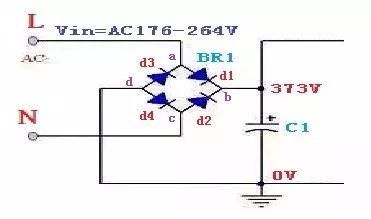ASEMI - "Key Rectifier Components" Voltage Stress Analysis!
Return ListSource:Asemi Date:2011.12.31 Read:0

First set up before testing and calculation, the circuit diagram is designed as above, the main parameters are as follows:
Input voltage: Vin=AC176-264V
Output voltage: Vout=12V
Vcc voltage: Vcc=15V
Transformer turns ratio: N
The stress calculation is performed on the rectifier bridge components in the picture below.

The rectifier bridge is composed of four diodes as shown in the figure: d1, d2, d3, d4
Worst case: when the input voltage max, that is, Vin=264Vac

Therefore, the voltage at both ends of C1 is 373V.
Input voltage waveform as shown below
When the input voltage is in the positive half cycle, the diodes d1 and d4 in the BR1 are not subjected to high voltage, d2 and d3 are cut off to withstand high voltage, d2 voltage stress is b point potential minus c point potential, d3 voltage stress is a point potential Subtract the d point potential.
The potentials of the positive half-cycles a, b, c, and d are 373V, 373V, 0V, 0V with respect to the large capacitance.
D2 stress = b-c = 373V - 0V = 373V
D3 stress = a-d = 373V-0V = 373V
When the input voltage enters the negative half cycle, the stress of d1 and d4 is 373V.
That is, the working stress of the rectifier bridge in the circuit is 373V.

 Hotline
Hotline



